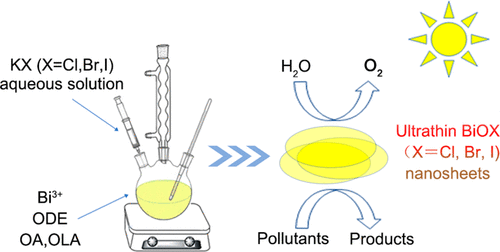当前位置:
X-MOL 学术
›
ACS Appl. Nano Mater.
›
论文详情
Our official English website, www.x-mol.net, welcomes your
feedback! (Note: you will need to create a separate account there.)
Ultrathin BiOX (X = Cl, Br, I) Nanosheets with Exposed {001} Facets for Photocatalysis
ACS Applied Nano Materials ( IF 5.3 ) Pub Date : 2020-01-24 , DOI: 10.1021/acsanm.0c00022 Zidong Wang , Zhe Chu 1 , Chunwei Dong , Ze Wang , Shiyu Yao , Hang Gao , Zhaoyu Liu , Yi Liu , Bai Yang , Hao Zhang
ACS Applied Nano Materials ( IF 5.3 ) Pub Date : 2020-01-24 , DOI: 10.1021/acsanm.0c00022 Zidong Wang , Zhe Chu 1 , Chunwei Dong , Ze Wang , Shiyu Yao , Hang Gao , Zhaoyu Liu , Yi Liu , Bai Yang , Hao Zhang
Affiliation

|
As a family of semiconductor photocatalysts, Sillén-type bismuth oxyhalides (BiOX, X = Cl, Br, I) have attracted widespread interest due to their excellent photocatalytic activity and photoconductivity. However, most current strategies on synthesizing ultrathin 2D BiOX nanosheets (NSs) rely on high temperature and pressure and complex procedures, which seriously confine their large-scale applications. Herein, we develop a simple and facile two-phase method for the synthesis of ultrathin 2D BiOX NSs with highly exposed {001} facets. On the basis of systematically studying the effects of various reaction parameters on the size, thickness, morphology, and composition of the products, the growth mechanism of ultrathin 2D BiOX NSs is presented, which indicates that the suppression of Bi3+ hydrolysis is required for the growth of 2D BiOX NSs with highly exposed {001} facets. The acidic condition prefers the growth of BiOX NSs with ultrathin structure and high crystallinity along the [001] zone axis. By using BiOBr NSs as the example, the photocatalytic activities of ultrathin 2D BiOX NSs are evaluated upon photodegradation of organic compounds and photocatalytic water oxidation. The results show that the organic compound photodegradation is mainly determined by the specific surface area of BiOBr NSs, while the O2 evolution rate of BiOBr NSs for water oxidation is dependent on their photogenerated charge separation efficiency. Because of the larger specific surface area and higher photogenerated charge separation efficiency, BiOBr-acid-0.5 ultrathin 2D NSs exhibits the fastest organic compound photodegradation rate and O2 evolution rate of 445.6 μmol g–1 h–1.
中文翻译:

超薄BiOX(X = Cl,Br,I)纳米片,具有暴露的{001}小平面用于光催化
作为半导体光催化剂家族,Sillén型卤化铋(BiOX,X = Cl,Br,I)由于其出色的光催化活性和光电导性而引起了广泛的关注。然而,目前合成超薄二维BiOX纳米片(NSs)的大多数策略都依赖于高温和高压以及复杂的程序,这严重限制了它们的大规模应用。本文中,我们开发了一种简单且容易的两相方法,用于合成具有高度暴露的{001}面的超薄二维BiOX NS。在系统研究各种反应参数对产物尺寸,厚度,形貌和组成的影响的基础上,提出了超薄二维BiOX NSs的生长机理,表明其对Bi 3+的抑制作用。具有高度暴露的{001}面的2D BiOX NSs的生长需要水解。酸性条件更倾向于沿[001]区域轴生长具有超薄结构和高结晶度的BiOX NS。以BiOBr NSs为例,通过有机化合物的光降解和光催化水氧化对超薄二维BiOX NSs的光催化活性进行了评价。结果表明,有机化合物的光降解主要取决于BiOBr NSs的比表面积,而O 2BiOBr NSs氧化水的速率取决于其光生电荷分离效率。由于更大的比表面积和更高的光生电荷分离效率,BiOBr-acid-0.5超薄2D NSs表现出最快的有机化合物光降解速率和O 2释放速率,为445.6μmolg –1 h –1。
更新日期:2020-01-26
中文翻译:

超薄BiOX(X = Cl,Br,I)纳米片,具有暴露的{001}小平面用于光催化
作为半导体光催化剂家族,Sillén型卤化铋(BiOX,X = Cl,Br,I)由于其出色的光催化活性和光电导性而引起了广泛的关注。然而,目前合成超薄二维BiOX纳米片(NSs)的大多数策略都依赖于高温和高压以及复杂的程序,这严重限制了它们的大规模应用。本文中,我们开发了一种简单且容易的两相方法,用于合成具有高度暴露的{001}面的超薄二维BiOX NS。在系统研究各种反应参数对产物尺寸,厚度,形貌和组成的影响的基础上,提出了超薄二维BiOX NSs的生长机理,表明其对Bi 3+的抑制作用。具有高度暴露的{001}面的2D BiOX NSs的生长需要水解。酸性条件更倾向于沿[001]区域轴生长具有超薄结构和高结晶度的BiOX NS。以BiOBr NSs为例,通过有机化合物的光降解和光催化水氧化对超薄二维BiOX NSs的光催化活性进行了评价。结果表明,有机化合物的光降解主要取决于BiOBr NSs的比表面积,而O 2BiOBr NSs氧化水的速率取决于其光生电荷分离效率。由于更大的比表面积和更高的光生电荷分离效率,BiOBr-acid-0.5超薄2D NSs表现出最快的有机化合物光降解速率和O 2释放速率,为445.6μmolg –1 h –1。











































 京公网安备 11010802027423号
京公网安备 11010802027423号